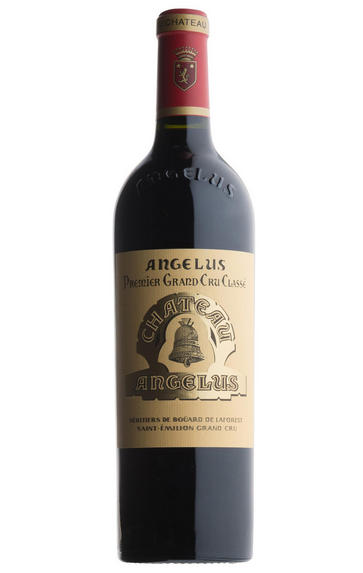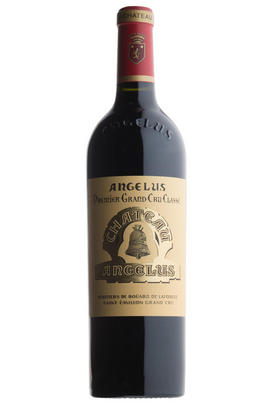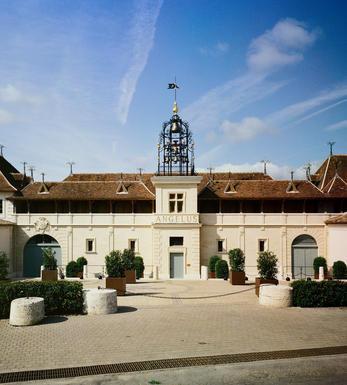
2007 Château Angélus, St Emilion, Bordeaux

Critics reviews
Intense and enticing campfire smoke, this has beautiful rich fruits behind the grilled aromatics and is open and just about ready to begin drinking. It's a lighter vintage in general across Bordeaux, but you see how Angléus over-delivers in these years, combining blackberry, redcurrant and blueberry fruits with orange peel and white truffle. Harvest September 25th to October 12th.
Drink 2021 - 2042
Jane Anson, Decanter.com (November 2021)
Tasted at BI Wine & Spirits' 10-Years-On tasting, the 2007 Angelus has a really quite wonderful bouquet with dark cherries, crushed strawberry, hints of orange blossom and cedar that contain much more energy than many of its peers. The palate is very crisp and nicely structured on the entry. The acidity is very well judged, and the silky smooth, lightly spiced finish has a sense of effortless charm. Everything here is just ticking along nicely. Excellent.
Drink 2017 - 2030
Neil Martin, Wine Advocate (June 2017)
Deep garnet with very little brick at the rim. Spicy and still showing lots of dark fruit and an attractive graphite quality, giving it a sombre elegance. A touch of char still there on the nose. On the palate, there’s a leafy freshness and very fine silky texture. Better length than any so far tasted in this line-up as well. Fresh and supple but with the depth to age better than most.
Drink 2017 - 2030
Julia Harding MW, JancisRobinson.com (June 2017)
This is a clean wine with a currant, berry and spicy character. Full body with soft tannins, a cherry, sweet tobacco, and a mineral undertone.
Drink now
James Suckling, JamesSuckling.com (October 2012)
A super effort from proprietor Hubert de Bouard, this blend of 62% Merlot and 38% Cabernet Franc exhibits sweet notes of chocolate, charcoal, blackberries, and jammy cherries in its round, opulent, fleshy personality. Yields were 35 hectoliters per hectare, and the wine achieved 13.5% natural alcohol. Low acidity and ripe tannin make for a voluptuous style of Angelus to drink now and over the next 10-15 years.
Drink 2010 - 2025
Robert M. Parker, Jr., Wine Advocate (April 2010)
Good deep ruby-red. Spicy aromas of blueberry, liquorice and bitter chocolate. Sweet, lush and deep but quite suave, with a lovely lift to the cabernet franc-driven violet, liquorice and peppery flavours. Firmly structured and long on the aftertaste. This already shows good mid-palate fat but really needs at least a few years to expand.
Stephen Tanzer, Vinous.com (July 2010)
About this WINE

Château Angélus
Château Angélus is one of the largest and most prestigious estates in St Emilion. It was promoted to Premier Grand Cru Classé A status in the 2012 reclassification. The de Boüard family has made wine here since 1782. The estate is now run by eighth-generation Stéphanie de Boüard-Rivoal, who took over from her father, Hubert de Boüard de Laforest, and uncle, Jean-Bernard Grenié, in 2012. It is located in centre-west of the St Emilion appellation, due west of the medieval town.
Angélus’s 39 hectares of vineyards are situated less than a kilometre away from the famous St Emilion steeple. The site enjoys a perfect southerly-exposed slope. Cabernet Franc is grown at the bottom, where the soils are sandier and warmer; Merlot is grown in the limestone-rich clay soils at the top of the slope.

St Émilion
St Émilion is one of Bordeaux's largest producing appellations, producing more wine than Listrac, Moulis, St Estèphe, Pauillac, St Julien and Margaux put together. St Emilion has been producing wine for longer than the Médoc but its lack of accessibility to Bordeaux's port and market-restricted exports to mainland Europe meant the region initially did not enjoy the commercial success that funded the great châteaux of the Left Bank.
St Émilion itself is the prettiest of Bordeaux's wine towns, perched on top of the steep limestone slopes upon which many of the region's finest vineyards are situated. However, more than half of the appellation's vineyards lie on the plain between the town and the Dordogne River on sandy, alluvial soils with a sprinkling of gravel.
Further diversity is added by a small, complex gravel bed to the north-east of the region on the border with Pomerol. Atypically for St Émilion, this allows Cabernet Franc and, to a lesser extent, Cabernet Sauvignon to prosper and defines the personality of the great wines such as Ch. Cheval Blanc.
In the early 1990s there was an explosion of experimentation and evolution, leading to the rise of the garagistes, producers of deeply-concentrated wines made in very small quantities and offered at high prices. The appellation is also surrounded by four satellite appellations, Montagne, Lussac, Puisseguin and St. Georges, which enjoy a family similarity but not the complexity of the best wines.
St Émilion was first officially classified in 1954, and is the most meritocratic classification system in Bordeaux, as it is regularly amended. The most recent revision of the classification was in 2012

Merlot
The most widely planted grape in Bordeaux and a grape that has been on a relentless expansion drive throughout the world in the last decade. Merlot is adaptable to most soils and is relatively simple to cultivate. It is a vigorous naturally high yielding grape that requires savage pruning - over-cropped Merlot-based wines are dilute and bland. It is also vital to pick at optimum ripeness as Merlot can quickly lose its varietal characteristics if harvested overripe.
In St.Emilion and Pomerol it withstands the moist clay rich soils far better than Cabernet grapes, and at it best produces opulently rich, plummy clarets with succulent fruitcake-like nuances. Le Pin, Pétrus and Clinet are examples of hedonistically rich Merlot wines at their very best. It also plays a key supporting role in filling out the middle palate of the Cabernet-dominated wines of the Médoc and Graves.
Merlot is now grown in virtually all wine growing countries and is particularly successful in California, Chile and Northern Italy.


Buying options
Add to wishlist
Description
Intense and enticing campfire smoke, this has beautiful rich fruits behind the grilled aromatics and is open and just about ready to begin drinking. It's a lighter vintage in general across Bordeaux, but you see how Angléus over-delivers in these years, combining blackberry, redcurrant and blueberry fruits with orange peel and white truffle. Harvest September 25th to October 12th.
Drink 2021 - 2042
Jane Anson, Decanter.com (November 2021)
wine at a glance
Delivery and quality guarantee